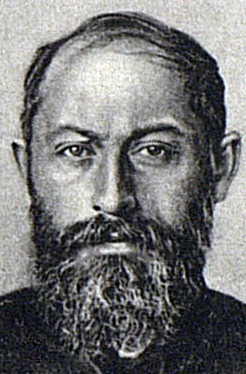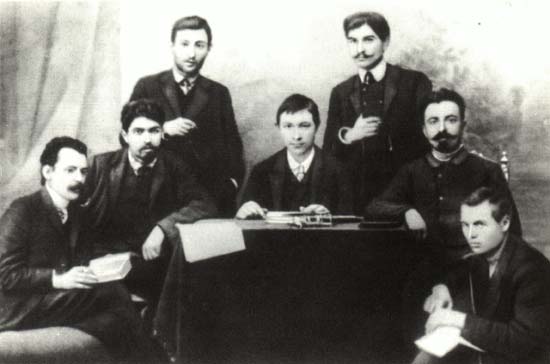|
Armenian Social-Democratic Workers Organization
The Armenian Social-Democratic Labour Organization ( hy, Սոցիալ-դեմոկրատական բանվորական հայ կազմակերպություն, ''Sotsial-Demokratakan Banvorakan Hai Kazmakerpoutiun'', abbreviated «ՍԴԲՀԿ», S.D.B.H.K.), often pejoratively referred to as the Specificists ( hy, սպեցիֆիկներ, ''spets’ifikner''), was an Armenian Marxist organization in the Russian Empire.TerMinassian Anaïde. Aux origines du marxisme arménien : Les spécifistes'. In: ''Cahiers du monde russe et soviétique'', vol. 19, n°1-2, Janvier-Juin 1978. Le Caucase. p. 67-117 History The S.D.B.H.K. was founded in Baku in October 1903 by a group of Armenians who had become Marxists during studies in Germany and Switzerland, as well as a few ex- Dashnaks, ex- Hunchak intellectuals and others. The group was, in particular, dissatisfied with the outcome of the 2nd Congress of the Russian Social Democratic Labour Party. The S.D.B.H.K. sought to establish trade unions ... [...More Info...] [...Related Items...] OR: [Wikipedia] [Google] [Baidu] |
Armenians
Armenians ( hy, հայեր, ''hayer'' ) are an ethnic group native to the Armenian highlands of Western Asia. Armenians constitute the main population of Armenia and the ''de facto'' independent Artsakh. There is a wide-ranging diaspora of around five million people of full or partial Armenian ancestry living outside modern Armenia. The largest Armenian populations today exist in Russia, the United States, France, Georgia, Iran, Germany, Ukraine, Lebanon, Brazil, and Syria. With the exceptions of Iran and the former Soviet states, the present-day Armenian diaspora was formed mainly as a result of the Armenian genocide. Richard G. Hovannisian, ''The Armenian people from ancient to modern times: the fifteenth century to the twentieth century'', Volume 2, p. 421, Palgrave Macmillan, 1997. Armenian is an Indo-European language. It has two mutually intelligible spoken and written forms: Eastern Armenian, today spoken mainly in Armenia, Artsakh, Iran, and the former Soviet ... [...More Info...] [...Related Items...] OR: [Wikipedia] [Google] [Baidu] |
Tiflis
Tbilisi ( ; ka, თბილისი ), in some languages still known by its pre-1936 name Tiflis ( ), is the capital and the largest city of Georgia, lying on the banks of the Kura River with a population of approximately 1.5 million people. Tbilisi was founded in the 5th century AD by Vakhtang I of Iberia, and since then has served as the capital of various Georgian kingdoms and republics. Between 1801 and 1917, then part of the Russian Empire, Tiflis was the seat of the Caucasus Viceroyalty, governing both the northern and the southern parts of the Caucasus. Because of its location on the crossroads between Europe and Asia, and its proximity to the lucrative Silk Road, throughout history Tbilisi was a point of contention among various global powers. The city's location to this day ensures its position as an important transit route for energy and trade projects. Tbilisi's history is reflected in its architecture, which is a mix of medieval, neoclassical, Beaux Art ... [...More Info...] [...Related Items...] OR: [Wikipedia] [Google] [Baidu] |
Shusha
/ hy, Շուշի , settlement_type = City , image_skyline = ShushaCollection2021.jpg , image_caption = Landmarks of Shusha, from top left:Ghazanchetsots Cathedral • Yukhari Govhar Agha MosqueShusha fortress • Shusha mountainsHouse of Mehmandarovs • City centerShusha skyline • House of Khurshidbanu Natavan , pushpin_map = Azerbaijan#Republic of Artsakh , coordinates = , subdivision_type = Country , subdivision_name = Azerbaijan Republic of Artsakh (claimed) , subdivision_type1 = District (Azerbaijan) , subdivision_name1 = Shusha , subdivision_type2 = Province (Artsakh, claimed) , subdivision_name2 = Shushi , established_title = Founded , leader_title1 = Mayor , leader_name1 = Bayram Safarov , leader_title2 ... [...More Info...] [...Related Items...] OR: [Wikipedia] [Google] [Baidu] |
Russian Revolution Of 1905
The Russian Revolution of 1905,. also known as the First Russian Revolution,. occurred on 22 January 1905, and was a wave of mass political and social unrest that spread through vast areas of the Russian Empire. The mass unrest was directed against the Tsar, nobility, and ruling class. It included worker strikes, peasant unrest, and military mutinies. In response to the public pressure, Tsar Nicholas II enacted some constitutional reform (namely the October Manifesto). This took the form of establishing the State Duma, the multi-party system, and the Russian Constitution of 1906. Despite popular participation in the Duma, the parliament was unable to issue laws of its own, and frequently came into conflict with Nicholas. Its power was limited and Nicholas continued to hold the ruling authority. Furthermore, he could dissolve the Duma, which he often did. The 1905 revolution was primarily spurred by the international humiliation as a result of the Russian defeat in the Russo-Japa ... [...More Info...] [...Related Items...] OR: [Wikipedia] [Google] [Baidu] |
Lenin
Vladimir Ilyich Ulyanov. ( 1870 – 21 January 1924), better known as Vladimir Lenin,. was a Russian revolutionary, politician, and political theorist. He served as the first and founding head of government of Soviet Russia from 1917 to 1924 and of the Soviet Union from 1922 to 1924. Under his administration, Russia, and later the Soviet Union, became a one-party socialist state governed by the Communist Party. Ideologically a Marxist, his developments to the ideology are called Leninism. Born to an upper-middle-class family in Simbirsk, Lenin embraced revolutionary socialist politics following his brother's 1887 execution. Expelled from Kazan Imperial University for participating in protests against the Russian Empire's Tsarist government, he devoted the following years to a law degree. He moved to Saint Petersburg in 1893 and became a senior Marxist activist. In 1897, he was arrested for sedition and exiled to Shushenskoye in Siberia for three years, where he married ... [...More Info...] [...Related Items...] OR: [Wikipedia] [Google] [Baidu] |
3rd Congress Of The Russian Social Democratic Labour Party
The 3rd Congress of the Russian Social Democratic Labour Party was held during 25 April - 10 May Old_Style_and_New_Style_dates.html"_;"title="12–27_April_Old_Style_and_New_Style_dates">O.S.)1905_in_ O.S.)">Old_Style_and_New_Style_dates.html"_;"title="12–27_April_Old_Style_and_New_Style_dates">O.S.)1905_in_London">Old_Style_and_New_Style_dates">O.S.)">Old_Style_and_New_Style_dates.html"_;"title="12–27_April_Old_Style_and_New_Style_dates">O.S.)1905_in_London,_United_Kingdom.html" ;"title="London.html" ;"title="Old Style and New Style dates">O.S.)">Old_Style_and_New_Style_dates.html" ;"title="12–27 April Old Style and New Style dates">O.S.)1905 in London">Old Style and New Style dates">O.S.)">Old_Style_and_New_Style_dates.html" ;"title="12–27 April Old Style and New Style dates">O.S.)1905 in London, United Kingdom">UK. The Menshevik Central Committee had voted against calling the Congress on 7 February 1905 and voted to expel Lenin. Two days later nine of the eleven members ... [...More Info...] [...Related Items...] OR: [Wikipedia] [Google] [Baidu] |
Noe Zhordania
Noe Zhordania ( ka, ნოე ჟორდანია /nɔɛ ʒɔrdɑniɑ/; russian: Ной Никола́евич Жорда́ния; born (or ) — January 11, 1953) was a Georgian journalist and Menshevik politician. He played an eminent role in the socialist revolutionary movement in the Russian Empire, and later chaired the government of the Democratic Republic of Georgia from July 24, 1918 until March 18, 1921, when the Bolshevik Russian Red Army invasion of Georgia forced him into exile to France. There Zhordania led the government-in-exile until his death in 1953. Biography Early life and background Zhordania was born on , to a petty landowner family living in the village of Lanchkhuti in Guria, western Georgia, then part of the Kutais Governorate of Imperial Russia.Zhorda ... [...More Info...] [...Related Items...] OR: [Wikipedia] [Google] [Baidu] |
Stepan Shaumian
Stepan Georgevich Shaumian (; , ''Step’an Ge'vorgi Shahumyan''; 1 October 1878 – 20 September 1918) was a Bolshevik revolutionary and politician active throughout the Caucasus. Arzumanyan, M. Շահումյան, Ստեփան Գևորգի. "Yerevan, Armenian SSR, vol. viii", ''The Soviet Armenian Encyclopedia'', 1982, pp. 431–34 Shahumyan was an ethnic Armenian and his role as a leader of the Russian revolution in the Caucasus earned him the nickname of the "Caucasian Lenin", a reference to the leader of the Russian Revolution, Vladimir Lenin. The founder and editor of several newspapers and journals, Shaumian is best known as the head of the Baku Commune, a short lived committee appointed by Lenin in March 1918 with the task of leading the revolution in the Caucasus and West Asia. His tenure as leader of the Baku Commune was marred with numerous problems including ethnic violence between Baku's Armenian and Azerbaijani populations, attempting to defend the city against a ... [...More Info...] [...Related Items...] OR: [Wikipedia] [Google] [Baidu] |
Stalin
Joseph Vissarionovich Stalin (born Ioseb Besarionis dze Jughashvili; – 5 March 1953) was a Georgian revolutionary and Soviet political leader who led the Soviet Union from 1924 until his death in 1953. He held power as General Secretary of the Communist Party of the Soviet Union (1922–1952) and Chairman of the Council of Ministers of the Soviet Union (1941–1953). Initially governing the country as part of a collective leadership, he consolidated power to become a dictator by the 1930s. Ideologically adhering to the Leninist interpretation of Marxism, he formalised these ideas as Marxism–Leninism, while his own policies are called Stalinism. Born to a poor family in Gori in the Russian Empire (now Georgia), Stalin attended the Tbilisi Spiritual Seminary before joining the Marxist Russian Social Democratic Labour Party. He edited the party's newspaper, ''Pravda'', and raised funds for Vladimir Lenin's Bolshevik faction via robberies, kidnappings and protection rac ... [...More Info...] [...Related Items...] OR: [Wikipedia] [Google] [Baidu] |
Caucasus
The Caucasus () or Caucasia (), is a region between the Black Sea and the Caspian Sea, mainly comprising Armenia, Azerbaijan, Georgia, and parts of Southern Russia. The Caucasus Mountains, including the Greater Caucasus range, have historically been considered as a natural barrier between Eastern Europe and Western Asia. Mount Elbrus in Russia, Europe's highest mountain, is situated in the Western Caucasus. On the southern side, the Lesser Caucasus includes the Javakheti Plateau and the Armenian highlands, part of which is in Turkey. The Caucasus is divided into the North Caucasus and South Caucasus, although the Western Caucasus also exists as a distinct geographic space within the North Caucasus. The Greater Caucasus mountain range in the north is mostly shared by Russia and Georgia as well as the northernmost parts of Azerbaijan. The Lesser Caucasus mountain range in the south is occupied by several independent states, mostly by Armenia, Azerbaijan, and Georgia, but also ... [...More Info...] [...Related Items...] OR: [Wikipedia] [Google] [Baidu] |
Revolutionary Ukrainian Party
The Revolutionary Ukrainian Party ( uk, Революційна Партія України) was a Ukrainian political party in the Russian Empire founded on 11 February 1900 by the Kharkiv student secret society Hromada. History The rise of the party came about with a successful consummation after other attempts from various public associations, such as the Brotherhood of Tarasovs and the Social-Democratic Circle of Ivan Steshenko and Lesya Ukrainka, were tried. Originally, the aim of R.U.P. was the independence of all Ukrainian national elements. What made the R.U.P. unique was the willingness to embrace all political philosophies, including socialism. The party officially arose at its First Congress in December 1902 when six party communities united into one political party in the following cities: Kharkiv, Poltava, Kyiv, Nizhyn, Lubny, and Yekaterinodar, as well as some smaller groups representing such cities as Romny, Pryluky, Odessa, Moscow and Saint Petersburg. The congr ... [...More Info...] [...Related Items...] OR: [Wikipedia] [Google] [Baidu] |
Communist Party Of Latvia
The Communist Party of Latvia ( lv, Latvijas Komunistiskā partija, LKP) was a political party in Latvia. History Latvian Social-Democracy prior to 1919 The party was founded at a congress in June 1904. Initially the party was known as the Latvian Social Democratic Workers' Party (LSDSP). During its second party congress in 1905 it adopted the programme of the Russian Social Democratic Labour Party (RSDLP) as its own. At the Fourth Congress of the RSDLP in 1906, the LSDSP entered the RSDLP as a territorial organisation, and after the congress its name was changed Social-Democracy of the Latvian Territory. The party held its fourth congress in Brussels January 26 to February 8, 1914. In May 1918 Latvian Social Democratic Workers' Party was founded by the Menshevik elements who had been expelled from the LSD. Rule in Soviet Latvia, 1919–1920 The party briefly governed the Latvian Socialist Soviet Republic in 1919; and changed its name to the Communist Party of Latvia in March ... [...More Info...] [...Related Items...] OR: [Wikipedia] [Google] [Baidu] |






